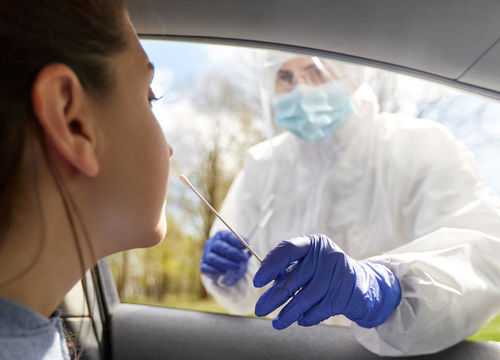October 2020 | Recent medical releases

Novel SARS-CoV-2 has spread worldwide and the scientific community is raging besides the pandemic emergence and the SARS-CoV-2 high pathogenicity 4. This pandemic has become one of the biggest worldwide health threats 5. Consequently, novel, costeffective and fast diagnostic techniques are required to improve the patient clinical management and treatment in order to limit the virus transmission and to improve public policies prioritizing the population safety. Appropriate specimen collection at the correct moment is of extreme importance for the accurate diagnosis of SARS-CoV-2. Currently, sampling is mostly based on upper respiratory tract samples 12. However, there are several other possible matrices for the detection such as lower respiratory tract specimens, serum, blood, urine, stool and saliva 8. Nasopharyngeal (NP) and oropharyngeal (OP) swabs are most commonly used, since they are recommended by the WHO 5. Comparing positive rate peaks of RT-PCR, some groups showed positive rates of 93% for bronchoalveolar lavages, 72% for sputum, 63% for nasal swabs and 32% for pharyngeal swabs 4,8,13. Moreover, the positive rate for NP and OP is only about 60-70% 8,14,15. Sputum is a sensitive matrix but sampling can be complex, because most of the infected patients do not generate sputum and also due to its high viscosity which can cause false negative PCR results. 8,16.
The current standard-of-care we recommend is the use of samples:
Proper sampling performed by well-trained staff is important to obtain a high-quality sample. Self-sampling is also accepted for NP/OP swabs if performed under the guidance of a healthcare professional.
“Mouthwash“ sample – recommendations for mouthwash sample use
Mouthwash (gargle) is a simple alternative and non-invasive method, which reduces patient discomfort and pain, healthcare workers’ exposure to aerosols, and also reduces requirements for PPE. Based on the SARS-CoV-2 cycle of infection, different groups have demonstrated that the oral cavity is a host for the virus 20-23. Mouthwash with gargle has the advantage of sampling the entire oral cavity (oral, buccal and gingival tissue) including posterior oropharyngeal, nasopharynx, tongue, saliva, deep-throat saliva, larynx and oral mucosa. During the gargling procedure with sterile saline solution, these zones are rich sources of epithelial cells liberated by the force of the cricopharyngeal muscle during oscillation over the posterior pharyngeal wall 5. Viral RNA has been detected from deep throat saliva even after treatment, with a high diagnosis rate for SARS-CoV-2 13. It is known that the SARS-CoV-2 virus attaches to human cell surfaces via angiotensin-converting enzyme 2 (ACE2). ACE2 is widely expressed including on epithelial cells lining minor salivary gland ducts, sinonasal cavity, pharynx, larynx, trachea and lungs. Interestingly, ACE2 expression levels are higher in salivary glands than in the lung 21. This highlights the utility of saliva and gargle samples as they include a complete sampling of the oral cavity. We note the importance of buccal epithelial cell recovery with our gargling method, since their expression of furin has been shown to be essential for zoonotic coronavirus infection 21,24-26.
General recommendations for mouthwash sample use
After an extensive internal validation process, SYNLAB recommends the use of mouthwash samples with these limitations and constraints:

1. Technical recommendations

2. Medical recommendations
Sputum or mouthwash can be used for such programs if NP/OP are not practicable, with the understanding that some low-viral titre (high-CT) individuals may be missed.


The spread of SARS-CoV-2 has become a serious challenge for public health, economy and social life in Europe and other regions of the world. To flatten the curve of new infections, not only social distancing and restrictions in public life but also fast and reliable testing plays an essential role.
SYNLAB is the leader in medical diagnostic services and specialty testing in Europe. Our mission is to provide advanced services in every diagnostic category for the benefit of you and your health. State-of-the-art technology, novel testing capabilities and an international network of medical professionals means we can offer a catalogue of more than 5000 routine and specialised tests. Fast, safe, reliable and always close by. We would like to welcome you to our world.
Forging links between medical disciplines and leading international specialists: because your success means a lot to us. Backed by SYNLAB’s team of international experts in more than 30 countries worldwide, we deliver diagnostic services of the highest calibre and make a significant contribution to interdisciplinary research.
Our expert teams and state-of-the-art diagnostic services are present in more than 30 countries on four continents. Get an insight into the history of our company and find out what drives us.
Find our job offers at our country pages and start your career with SYNLAB, the leader in medical diagnostic services and specialty testing in Europe.